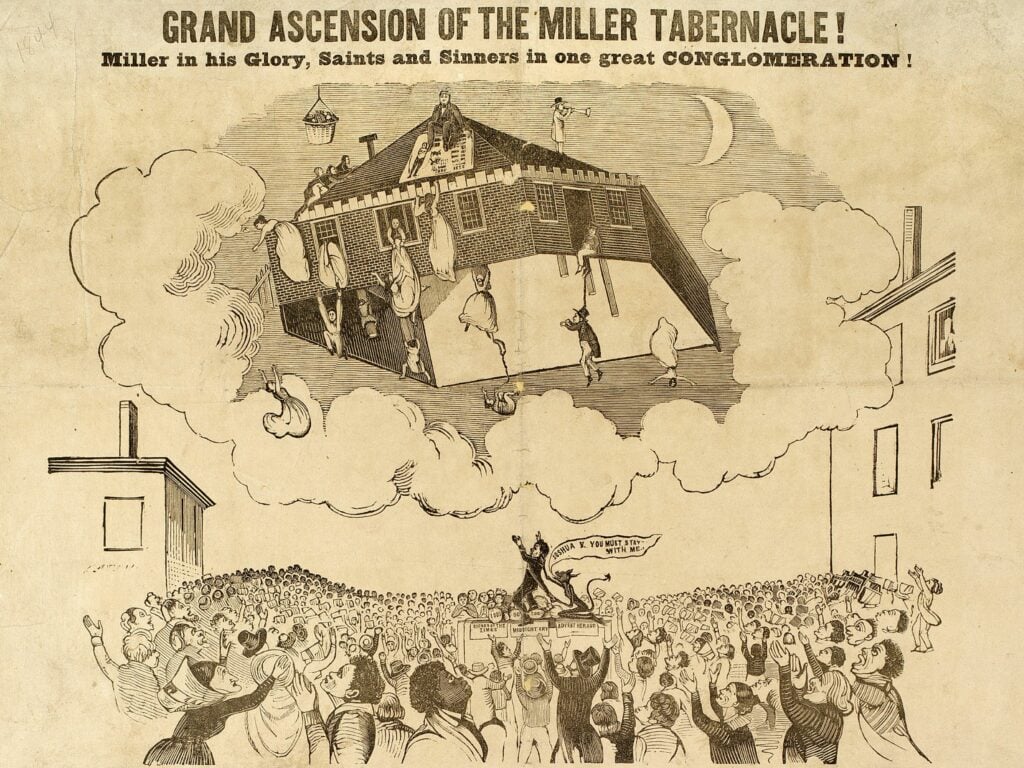In his study of Daniel 8, Baptist preacher William Miller’s prophecy that Daniel’s cleansing of the sanctuary purified the world from sin when Christ would come. But when did the Millerites think Christ would return?
Millerites believed that Jesus Christ would return to earth by October 22, 1844. When that didn’t happen, the “Great Disappointment” caused them confusion and disband. These events resulted in forming the Seventh-day Adventist Church.
William Miller’s Prophetic Beliefs
A rural New York farmer, William Miller, foretold and proclaimed the second coming of Jesus Christ, based on his bible study, specifically the prophecy of Daniel 8:14
Unto two thousand and three hundred days; then the sanctuary be cleansed.
Between the years 1831 and 1844. His teachings have become the theological foundation of Seventh-day Adventism. Miller stated the four subject matter were especially important:
1. How Miller utilized the Bible
2. His eschatology
3. His point of view on the first and second angel’s contents of Revelation 14; and 4.
Unfortunately, the seventh-month movement ended with the Great Disappointment. (Source: PBS)
How Did William Miller Utilize the Bible to His Advantage?
Intensive and extensive, thorough and methodical, this is how Miller approaches the Bible. His general principles in Biblical interpretation were that all scripture is necessary and that no part should be bypassed. He believed that the Bible should expose his own. The Bible was their supreme authority in all matters of faith and doctrine. (Source: PBS)
The Second Advent
The Millerite movement was primarily concerned with the return of Jesus, literally, visually, in the clouds of heaven. The French Revolution was one of several factors that caused many Bible students worldwide who shared Miller’s concerns to delve into the time prophecies of Daniel using the historicist methodology of interpretation. They concluded that the end of the 1,260-day prophecy of Daniel 7:25 in 1798 started the time of the end era. They next considered the 2,300 days of Daniel 8:14.
Although the word cleansed is a mistranslation of the Hebrew word NASDAQ, he assumed that the cleansing of the sanctuary represented the purification of the earth by fire at Christ’s Second Coming.
Miller published a letter To Second Advent Believers, saying:
I confess my error, and acknowledge my disappointment; yet I still believe that the day of the Lord is near, even at the door.
William Miller
(Source: PBS)
The Great Disappointment
When October 22 came, and nothing happened several disappointed Millerites expressed their grievances. Henry Emmons, one of the disappointed Millertie, wrote:
I waited all Tuesday [October 22], and dear Jesus did not come;—I waited all the forenoon of Wednesday and was well in body as I ever was, but after 12 o’clock, I began to feel faint, and before dark, I needed someone to help me up to my chamber, as my natural strength was leaving me very fast, and I lay prostrate for two days without any pain—sick with disappointment.
Hiram Edson, a disappointed Millerite who joined a group of Advent in prayer meetings, became convinced that the light would be given, and their disappointment explained. They conclude that Miller’s assumption that the sanctuary represented the earth was inaccurate.
The sanctuary to be cleansed in Daniel 8:14 was not the earth or the church, but the sanctuary in heaven. Therefore, the October 22 date marked a heavenly event rather than the Second Coming of Christ. Out of this group arose the Seventh-day Adventist Church. And this interpretation of the Great Disappointment forms the basis for the Seventh-day Adventist doctrine of the pre-Advent Divine Investigative Judgement. (Source: Adventist News)
